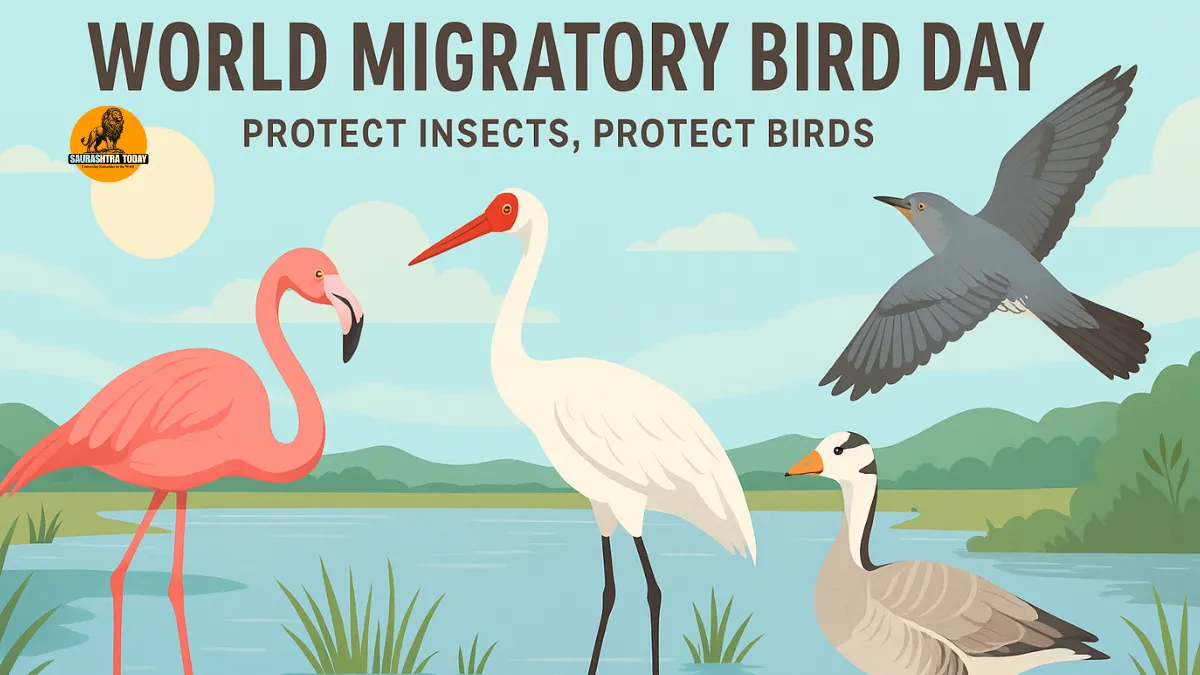World Migratory Bird Day 2025: As millions of birds take to the skies each year, crossing continents and oceans in one of nature’s most breathtaking spectacles, the world pauses to celebrate World Migratory Bird Day 2025. This year’s theme — “Protect Insects, Protect Birds” — reminds us that even the smallest creatures on Earth play a crucial role in sustaining the magnificent journeys of migratory birds.
Why Do Birds Migrate?
Bird migration is one of the most extraordinary natural events on our planet. The main reason behind this epic movement is simple — survival. Birds travel thousands of miles in search of food, better climate, and safe breeding grounds.
During the cold winters of northern regions, food becomes scarce. Insects vanish, seeds freeze, and nectar dries up. Birds, therefore, move to warmer areas like South Asia, Africa, and South America, where resources remain available year-round.
When spring returns, they fly back north to breed. Longer days and abundant food help them raise their young successfully. Migration also helps reduce competition for resources, ensuring that different bird populations can share global ecosystems in balance.
A Global Celebration: World Migratory Bird Day
World Migratory Bird Day (WMBD) is celebrated twice every year — in May and in October — symbolizing the two main migration periods across the hemispheres. It is a joint initiative by the Convention on Migratory Species (CMS), AEWA (African-Eurasian Migratory Waterbird Agreement), and Environment for the Americas (EFTA).
The 2025 theme, “Protect Insects, Protect Birds,” emphasizes how the decline of insect populations is directly affecting bird survival. Insects are a primary food source for many migratory birds, especially during breeding and rearing periods. Pesticide use, habitat loss, and climate change are rapidly diminishing insect populations, creating a ripple effect across ecosystems.
India’s Role in Bird Migration
India plays a vital role in the Central Asian Flyway, one of the major migratory routes of the world. Every year, over 400 species of migratory birds visit the Indian subcontinent.
From Siberian Cranes in Bharatpur (Rajasthan) to Flamingos in the Rann of Kutch (Gujarat) and Bar-headed Geese in Ladakh, India’s wetlands, forests, and coastal regions serve as critical stopover and wintering sites.
Conservation projects like the Keoladeo National Park (UNESCO World Heritage Site) and Chilika Lake in Odisha have become safe havens for these travelers of the sky. However, increasing pollution, land reclamation, and water scarcity continue to threaten these fragile habitats.
How Birds Navigate: The Science Behind Migration
The precision with which birds travel thousands of miles is one of nature’s greatest wonders. Scientists have discovered that birds rely on a mix of natural cues and sensory mechanisms to find their way.
1. Celestial and Solar Navigation
Birds use the sun during the day and stars at night as navigational tools. They learn star patterns early in life and adjust their routes using the position of the sun.
2. Earth’s Magnetic Field
Many species possess special magnetoreceptors — cells that sense the Earth’s magnetic field — allowing them to act as living compasses even when skies are cloudy.
3. Visual Landmarks and Smell
Geographical features like rivers, coastlines, and mountains serve as memory maps. Some species even use olfactory cues (smells) and environmental sounds, like ocean waves, to orient themselves.
4. Climate and Wind Patterns
Recent studies show that birds can sense barometric pressure and wind direction, adjusting their flight patterns to conserve energy and avoid storms.
Physical Adaptations for Long-Distance Travel
Migratory birds have evolved incredible physical adaptations to survive their marathon journeys:
- Powerful flight muscles that make up over 25% of their body weight.
- Streamlined, aerodynamic bodies that reduce drag.
- Specialized wing shapes — long and narrow for gliding seabirds; broad and rounded for maneuvering forest birds.
- Fat reserves built up through hyperphagia — a feeding frenzy before migration that doubles their weight.
- Unihemispheric sleep, allowing one half of the brain to rest while flying.
Some birds, like the Bar-tailed Godwit, can fly non-stop for up to 11 days, traveling 7,000 miles without landing.
Record-Breaking Journeys in the Sky
Every migration season brings awe-inspiring stories of endurance:
- Arctic Tern: The world’s longest migrator, traveling nearly 44,000 miles annually from the Arctic to Antarctica and back.
- Bar-tailed Godwit: Flies non-stop from Alaska to New Zealand, covering 7,000 miles.
- Amur Falcon: A remarkable raptor that migrates from Siberia to Southern Africa, with India as its key stopover site in Nagaland.
- Ruby-throated Hummingbird: Weighing just a few grams, it crosses the Gulf of Mexico (500 miles) in a single flight.
These journeys reflect both resilience and the interconnectedness of ecosystems across continents.
The Growing Challenges of Migration
Migration is a life-or-death journey, and modern threats have made it more perilous than ever.
1. Habitat Destruction
Wetlands and forests that serve as refueling stops are being lost to agriculture, construction, and pollution.
2. Climate Change
Unpredictable weather disrupts migration timing. Birds may reach breeding grounds before food sources appear, reducing chick survival rates.
3. Light and Noise Pollution
Artificial lighting disorients night migrators, while noise pollution interferes with their communication.
4. Hunting and Poaching
Despite international bans, migratory birds are still hunted in parts of the Mediterranean, South Asia, and Africa.
5. Decline in Insects
With the 2025 theme focusing on insects, scientists warn that pesticide-driven insect declines are already reducing food availability for many migratory species.
Also read: Jamnagar’s Karuna Animal Ambulance 1962 Saves Over 38,000 Animals in Eight Years
Why Bird Migration Matters
Migratory birds are more than beautiful travelers — they are essential to the planet’s health. They help with pollination, seed dispersal, pest control, and nutrient cycling across continents.
A drop in bird populations is often the first sign of ecosystem imbalance. For instance, fewer insect-eating birds can lead to pest outbreaks, affecting crops and food security.
Modern Science and Bird Tracking
Thanks to technology, scientists now track migration more accurately than ever.
- Satellite telemetry and GPS tags provide real-time data on bird movements.
- Radar monitoring helps visualize mass migrations over regions.
- DNA analysis and isotopic studies reveal genetic and environmental factors influencing migration patterns.
India, through organizations like the Bombay Natural History Society (BNHS) and the Indian Bird Conservation Network, is using such tools to better understand and protect migratory routes.
Also read: President Draupadi Murmu Visits Sasan Gir for Lion Safari and Tribal Engagement
Global and Local Conservation Efforts
To protect migratory birds, international cooperation is essential.
Key agreements include:
- Convention on Migratory Species (CMS)
- Ramsar Convention on Wetlands
- Migratory Bird Treaty Act (USA)
- India’s National Action Plan for Conservation of Migratory Birds
Locally, steps like reducing night lighting, creating bird sanctuaries, protecting wetlands, and encouraging eco-friendly agriculture are making an impact.
What Can We Do to Help?
You don’t need to be a scientist to help migratory birds. Small actions count:
- Grow native plants that attract insects and provide food.
- Avoid using chemical pesticides.
- Turn off unnecessary lights at night.
- Keep glass windows bird-safe to prevent collisions.
- Support local conservation organizations.
Also read: Vantara: The World’s Largest Animal Rescue Center and the Debate Around Rare Species
A Flight for the Future
The phenomenon of bird migration is a story of endurance, intelligence, and global connection. As we celebrate World Migratory Bird Day 2025, let’s remember that every bird in the sky depends on a web of ecosystems — and on our collective effort to protect them.
By saving insects, restoring habitats, and reducing pollution, we’re not just helping birds — we’re preserving the balance of life that sustains us all.
Let’s honor the sky travelers of our planet this World Migratory Bird Day — for their wings carry not just their lives, but the very rhythm of nature itself.
Frequently Asked Questions (FAQs)
What is the theme of World Migratory Bird Day 2025?
The theme is “Protect Insects, Protect Birds.” It highlights how insects are vital to the survival of migratory species.
When is World Migratory Bird Day celebrated?
It is celebrated twice a year — in May and October — aligning with seasonal migrations in different hemispheres.
Which bird travels the longest distance?
The Arctic Tern travels nearly 44,000 miles annually, the longest migration known in the animal kingdom.
Why are migratory birds important?
They maintain ecological balance by controlling pests, dispersing seeds, and enriching ecosystems globally.
How can people help migratory birds?
Plant native vegetation, reduce pesticide use, minimize artificial lighting, and support wetland conservation efforts.
















